Several troubling events have transpired on the Korean Peninsula in recent weeks, reflecting a breakdown in inter-Korean relations and raising the specter of conflict.
Inter-Korean relations had already been spiraling downward since 2020 when North Korea blew up a joint liaison office with South Korea at the Kaesong Industrial Complex. However, actions taken by North Korea over the past few months, including a military satellite launch, an intercontinental ballistic missile (ICBM) test, artillery fire along the Northern Limit Line (NLL), the testing of another underwater nuclear drone, and the disavowal of reunification with South Korea, point to more provocations in 2024, especially as South Korea and the United States prepare for elections. Seoul and Washington must respond to escalated threats but do so without triggering yet another crisis on the heels of the ongoing conflicts in Ukraine and in Gaza-Israel.
Ending reunification as a stated goal
Perhaps the most significant but least understood action in recent weeks is North Korean leader Kim Jong Un’s decision to end his country’s long-stated goal of reunification with South Korea. In a speech to the Supreme People’s Assembly on January 15, Kim called for constitutional revisions to refer to South Korea as the “principal enemy.” North Korea would no longer treat the South as a “partner of reconciliation and reunification.” The comments echoed remarks Kim made at an end-of-year speech to party officials in which he blamed South Korea’s collusion with foreign forces and its hostile position toward Pyongyang as reasons for giving up on reunification.
Since the division of the Korean Peninsula, inter-Korean relations have been mostly hostile. The two Koreas periodically pursued cooperation to promote reconciliation and reunification (albeit on each Korea’s own terms), and did so as recently as 2018-19. However, Kim’s reversal means that the regime will treat South Korea as its “number one hostile country.”
The regime has already begun scrubbing all references to “peaceful reunification” and “great national unity” from North Korean media, monuments, and other public outlets. Beyond the symbolism, Kim’s attempt to dismantle the unification narrative promulgated by his father and grandfather allows him to redefine South Korea as a “foreign” state. Such steps help further legitimize a future attack against South Korea.
Increased military tension
Although the number of North Korean ballistic missile tests in 2023 did not exceed the record-breaking number the country conducted in 2022, Pyongyang still tested five ICBMs along with dozens of other short- and intermediate-range missiles. The regime’s advances in space and cyber capabilities and deepening ties with Moscow have also worried South Korean leaders. After two earlier failed attempts in 2023, North Korea successfully launched a military reconnaissance satellite into orbit on November 21, with likely assistance from Russia, according to South Korean intelligence.
North Korea’s actions led Seoul to partially suspend the 2018 Comprehensive Military Agreement (CMA) with Pyongyang. The CMA emerged during an era of high-level inter-Korean engagement to reduce military tensions near the border by restricting surveillance, military movement, and live-fire exercises along the North-South border. Although North Korea allegedly breached the CMA in over 3,000 incidents in five years, Pyongyang also declared its abandonment of the CMA and threatened to “deploy more powerful armed forces and new-type military hardware.”
Then on January 5, North Korea fired hundreds of artillery shells from its western coast toward the Northern Limit Line (NLL) — the de facto maritime boundary between the two Koreas. South Korean civilians on nearby islands sought shelter, evoking memories of North Korea’s shelling of Yeonpyeong Island in 2010 which killed two South Korean soldiers. The South Korean military responded by firing over 400 rounds of artillery just south of the NLL.
The leaders of the two Koreas have since been engaged in a war of words and tit-for-tat actions. Touring a munitions factory on January 10, Kim stated that North Korea would not hesitate to “thoroughly annihilate” the South if provoked. Meanwhile, South Korean President Yoon Suk Yeol vowed to punish North Korea “multiple times over” should it attack South Korea.
Spillover effects
Escalating tensions on the Korean Peninsula are not isolated to inter-Korean relations. Over the past year, the United States, South Korea, and Japan have boosted trilateral cooperation in response to North Korean missile, nuclear, and cyber threats. Meanwhile, North Korea has supplied Russia with short-range ballistic missiles in return for economic, scientific, humanitarian, and military assistance from Russia. Increased rail and ship movements across the Russia-North Korea border have raised suspicion of an uptick in arms transfers from Pyongyang to Moscow.
White House officials have described the level of Russia-North Korea military cooperation as “unprecedented” and warned it could “drastically” change the nature of the threat in the region. Underscoring these relations, North Korean Foreign Minister Choe Son Hui visited Russian Foreign Minister Sergey Lavrov and President Vladimir Putin in Moscow last week, setting up Putin’s likely visit to North Korea in the near future.
The possibility of a growing North Korea-Russia-China axis only emboldens Kim and bolsters North Korea’s geostrategic position. Meanwhile, some South Koreans worry that strengthened U.S.-Japan-South Korea cooperation may result in a spiraling arms race in Northeast Asia. Last week, the United States, Japan, and South Korea conducted their largest trilateral naval drill to date in the Yellow Sea, but it did little to prevent North Korea from making further provocations. Responding to what the regime called “hostile military maneuvers of the navies of the U.S. and its allies,” North Korea asserted that it had tested an underwater nuclear-capable drone.
Implications for 2024
Three factors may explain North Korea’s shift on inter-Korean relations and increased aggression in the first weeks of 2024:
- Kim believes reunification is now futile with the Yoon government moving in lockstep with the United States and adopting a harder line towards North Korea. Whereas Kim was able to use inter-Korean engagement with the previous Moon Jae-in government to reach out to Washington, the North Korean leader now seeks to marginalize Seoul. Yoon’s appointment of more hawkish leaders at the Ministry of Defense and Ministry of Unification in the second half of 2023 may also have been interpreted by Kim as a threat to the regime. For instance, Minister of Unification Kim Yung Ho’s staunch support for North Korean human rights and statements about regime change prior to his appointment may have angered Kim Jong Un, further prompting the North Korean leader to see the two Koreas as incompatible.
- Strengthened U.S.-South Korea relations and the direction of U.S.-Japan-South Korea trilateral cooperation have pushed North Korea to increase its own capabilities and reorient its diplomacy to prioritize relations with Russia and China. North Korea appears more, not less, confident than a year ago, despite serious economic problems.
- Kim may be seeking to influence election outcomes in South Korea and the United States in April and November, respectively. By spotlighting the Yoon and Biden governments’ inability to rein in North Korea’s nuclear threat, Kim may be hoping to boost support for parties and candidates seen as more favorable to the regime’s long-term goals. South Korean progressives generally seek reconciliation and engagement with North Korea in contrast to the conservative parties’ more hardline positions. Regarding U.S. elections, Kim would prefer a candidate more willing to accept North Korean nuclear weapons. Based on sources from a recent Politico report, former President Donald Trump could fit this bill. Kim would also welcome the potential disruption of U.S. alliances under a Trump presidency, including a weakened U.S.-South Korea alliance.
A more belligerent North Korea will take up additional bandwidth in Washington and Seoul in an important election year for both countries. Both sides will need to continue coordinating their policies to reduce misperceptions and avoid misjudging North Korean intentions. Although the United States remains preoccupied with conflict in the Middle East and Ukraine, it will need to continue strengthening defense and deterrence measures with South Korea and Japan and possibly lean on China to prevent North Korea from upsetting a fragile peace in Northeast Asia.
-
Acknowledgements and disclosures
The author would like to thank Hanna Forman for her research assistance and Adam Lammon for editing.

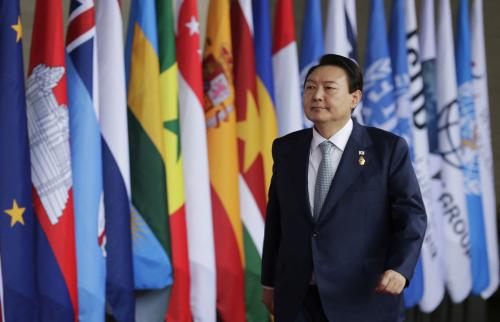
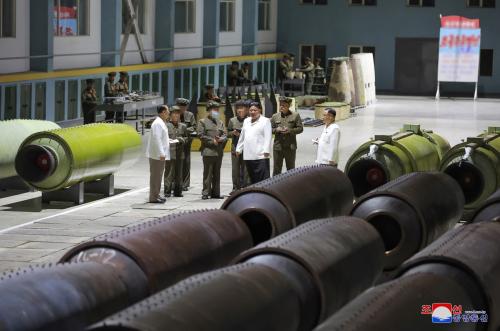
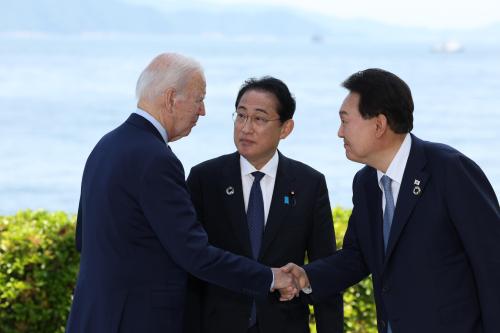
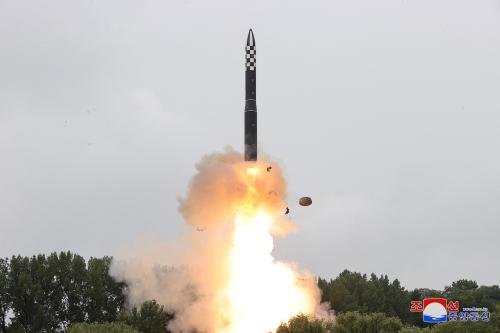
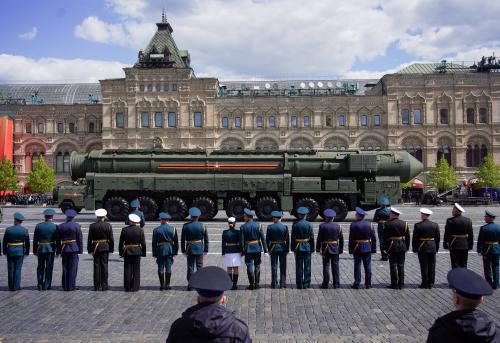
Commentary
On the brink: Why inter-Korean relations have reached a new low
January 24, 2024